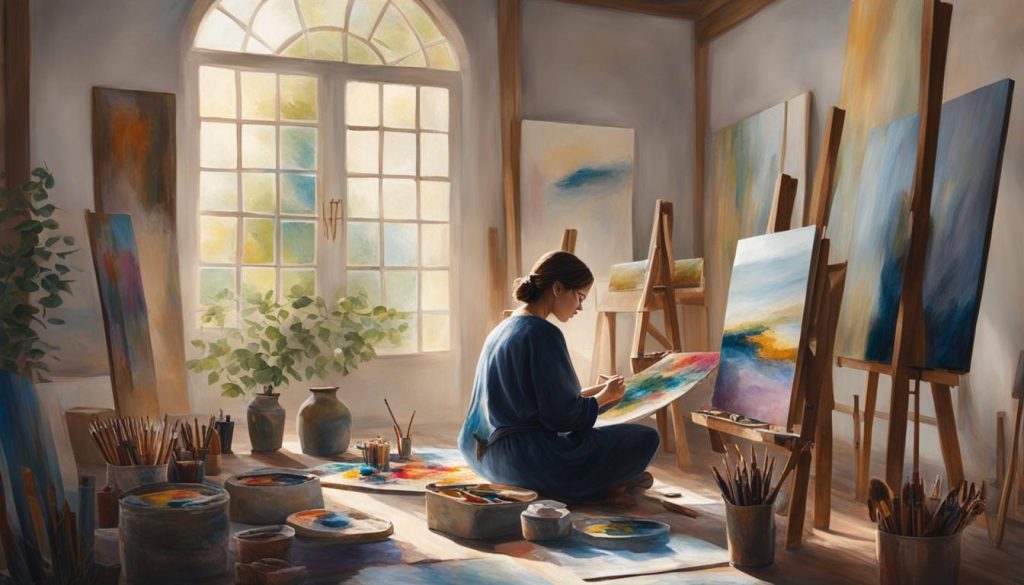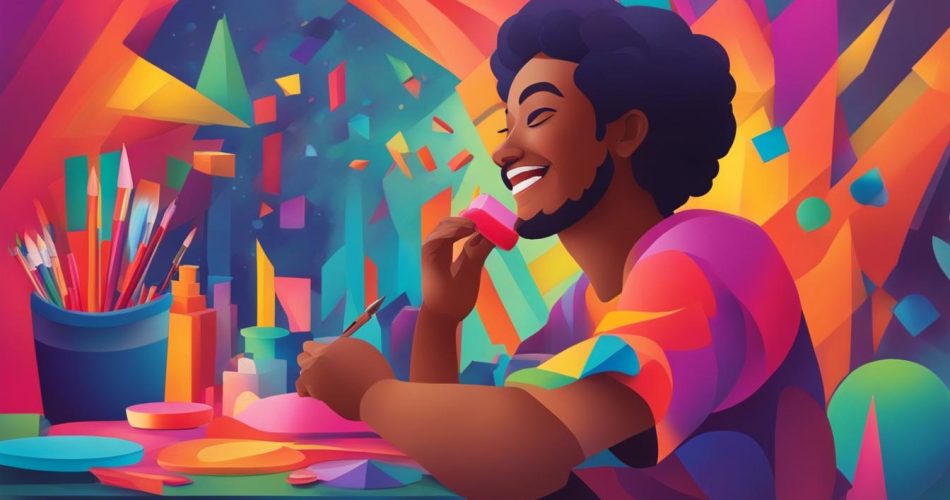Greetings! I’m here to share with you the incredible benefits of art therapy for stress relief. In our fast-paced lives, stress has become a common companion, affecting our mental and physical well-being. But fear not, because creativity has a powerful role to play in relieving stress and promoting overall wellness.
Art therapy, a form of treatment that harnesses the power of creative expression, has been proven to have a profound impact on our mental health. By engaging in creative activities, such as painting, drawing, or sculpting, we tap into the therapeutic qualities of art, which foster mindfulness and relaxation.
When we immerse ourselves in the process of creating art, our minds become focused on the present moment, providing a welcome distraction from the stressors of daily life. This allows us to reduce anxiety and cultivate a state of calm. Moreover, art therapy offers a safe space for the expression of emotions, serving as a valuable tool for addressing issues such as depression and anxiety.
Engaging in art therapy can also have a positive social impact. Participating in group creative activities or sharing our artwork with others fosters social connection and reduces feelings of isolation and loneliness.
So, are you ready to explore the world of art therapy and discover its incredible benefits for stress relief? Let your inner artist shine and embrace the transformative power of creativity!
Key Takeaways:
- Art therapy promotes mindfulness and relaxation, reducing stress and anxiety.
- Engaging in creative activities allows for the expression of emotions and can help improve depression and anxiety.
- Art therapy provides a healthy distraction from stressors and promotes a state of calm.
- Participating in group creative activities fosters social connection and reduces feelings of isolation.
- Embrace art therapy as a valuable tool for stress relief and overall well-being.
The Power of Creativity for Mental Health
Creativity plays a significant role in supporting mental health and well-being. Art therapy has been shown to be highly beneficial for individuals dealing with mental health conditions such as anxiety and depression. Through the act of creating art, individuals can effectively express their emotions, release feelings of stress and tension, and foster a sense of inner calm and relaxation.
Art therapy also serves as a powerful tool for self-awareness and self-reflection. Engaging in the creative process allows individuals to delve deep into their emotions, gaining a better understanding of their thoughts and feelings. It provides a safe space for exploring and addressing complex emotions that may be difficult to express verbally.
Furthermore, art therapy can play a pivotal role in building self-confidence and promoting a sense of accomplishment. Creating art allows individuals to tap into their unique abilities and talents, fostering a sense of pride and achievement. It offers a tangible representation of one’s creative expression, serving as a visual reminder of personal growth and resilience.
I firmly believe that art therapy can be a transformative tool for individuals struggling with anxiety and depression. The act of creation, whether it’s through painting, drawing, or other artistic mediums, allows individuals to find solace, process their emotions, and discover new strengths within themselves.
By engaging in art therapy, individuals can tap into their innate creativity and utilize it as a means of healing and self-discovery. It provides a unique outlet for self-expression, enabling individuals to communicate their innermost thoughts and emotions in a non-verbal, yet profoundly impactful way.
The Benefits of Art Therapy for Mental Health
Art therapy holds numerous benefits for individuals seeking improved mental health:
- Emotional release: Art therapy provides a safe space for individuals to release pent-up emotions and express themselves freely.
- Stress reduction: Engaging in creative activities helps to alleviate stress and promote a state of relaxation and mindfulness.
- Self-reflection and self-awareness: Creating art allows individuals to gain insights into their own thoughts, feelings, and experiences.
- Self-confidence and empowerment: Art therapy fosters a sense of accomplishment and self-esteem, empowering individuals to embrace their unique creative abilities.
In conclusion, art therapy holds immense potential for promoting mental health and overall well-being. It harnesses the power of creativity to help individuals manage anxiety and depression, while also facilitating self-expression and personal growth. By embracing art as a therapeutic tool, individuals can embark on a transformative journey of self-discovery, finding solace and healing within their creative endeavors.
How Art Therapy Works
Art therapy is a unique and effective form of mental health treatment that harnesses the power of creativity to facilitate emotional healing and personal growth. Through the use of various art therapy techniques and exercises, individuals are able to explore their emotions, gain self-awareness, and find solace in the process of creating.
The main goal of art therapy is to help individuals relax and establish a deeper connection with their emotions. By engaging in art therapy exercises, individuals can find a safe and expressive outlet for their feelings, allowing for a better understanding of their thoughts and experiences.
Art therapy exercises encompass a wide range of activities that cater to different interests and skill levels. Some common techniques include:
- Ceramics and Clay Work: Creating pottery or sculpting with clay allows individuals to physically mold their emotions and experiences, providing a tangible representation of inner emotions.
- Doodling or Scribbling: These intuitive and spontaneous drawing exercises enable individuals to freely express their emotions without the confinement of formal techniques or expectations.
- Collages: Creating collages using various materials such as magazine cut-outs, photographs, and fabric enables individuals to visually represent their thoughts and feelings in a symbolic and metaphorical way.
- Coloring Books: Coloring intricate designs in coloring books offers a therapeutic and soothing experience, allowing individuals to focus their attention on the present moment and engage in mindful coloring.
These art therapy exercises provide individuals with a structured activity that encourages self-reflection and emotional exploration. The creative process itself becomes a form of meditation, diverting attention away from stressors and worries and promoting a sense of calm and relaxation.
Art therapy also fosters a sense of empowerment and self-expression. It allows individuals to communicate their emotions non-verbally, offering a safe space for processing difficult experiences, trauma, and complex emotions. Through art therapy, individuals can develop a deeper understanding of themselves and their unique journeys.
The Benefits of Art Therapy

Engaging in art therapy offers a range of benefits. It fosters self-awareness, allowing individuals to tune into their emotions, thoughts, and body. Art therapy also helps individuals process and understand their emotions, enabling them to identify the roots of their troubles. It offers an emotional release, allowing individuals to let go of past trauma and stagnant emotions. Additionally, art therapy builds self-confidence and promotes self-worth and self-esteem.
Various art therapy activities provide opportunities for self-expression and creative exploration. These activities include:
- Ceramics and clay work: Engaging with clay and ceramics allows individuals to use their hands to mold and shape their creations. The tactile nature of this activity can be therapeutic, offering a sensory experience that promotes relaxation and self-expression.
- Sculpting: Sculpting allows individuals to bring their ideas and emotions to life through three-dimensional forms. It encourages a sense of focus and concentration, providing a meditative and introspective experience.
- Collages: Creating collages involves the combination of different materials, such as images, textures, and colors. This activity allows individuals to express themselves visually, explore their creativity, and communicate their emotions.
- Art journals: Keeping an art journal provides a private space for self-reflection and expression. Individuals can freely incorporate drawings, paintings, writing, and other art forms to document their thoughts, feelings, and experiences.
Through these art therapy activities, individuals can unleash their creativity, delve into their emotions, and find solace in the process of self-expression. Art therapy provides a safe and nurturing environment for individuals to explore their inner world, ignite their imagination, and discover new insights about themselves.
“Art enables us to find ourselves
and lose ourselves at the same time.”
– Thomas Merton
The Impact of Drawing and Painting on Stress Reduction

Drawing and painting have proven to be highly effective forms of stress relief. Numerous studies have demonstrated that engaging in these creative activities can result in significant reductions in cortisol levels, a hormone closely associated with stress. When we pick up a pencil or a paintbrush, something remarkable happens: we enter a state of relaxation and mindfulness, enabling us to concentrate on the present moment and redirect our attention away from negative thoughts.
The act of drawing and painting provides us with a unique outlet for our emotions, allowing us to express ourselves freely and process and release stress. The rhythmic strokes of a paintbrush or the deliberate lines of a drawing can be incredibly soothing, offering a sense of solace and tranquility. Through these artistic endeavors, we can explore our inner world, giving shape and form to our feelings, thus alleviating the weight of stress that burdens us.
“Art enables us to find ourselves and lose ourselves at the same time.” – Thomas Merton
When we engage in drawing and painting, we tap into our creative energy, which has a powerful influence on our mental and emotional well-being. Creating art provides a respite from the demands and pressures of daily life, granting us the freedom to immerse ourselves in the artistic process. By focusing on colors, shapes, and textures, we shift our attention away from stressors and find solace in the act of creation itself.
The Role of Artistic Expression in Stress Reduction
Artistic expression through drawing and painting allows us to delve into our subconscious and tap into our innermost thoughts and emotions. By translating these intangible aspects of ourselves into a visual form, we regain a sense of control and understanding over our experiences. Through the stroke of a brush or the precise lines of a drawing, we can communicate what words alone often fail to convey.
Furthermore, drawing and painting offer us a meditative and therapeutic experience. As we engage in these creative activities, we enter a state of flow, where time seems to stand still and our worries fade into the background. This state of flow is deeply calming and rejuvenating, providing a much-needed respite from the constant barrage of stress in our lives.
In summary, drawing and painting have a profound impact on stress reduction. Engaging in these creative activities allows us to relax, find solace in the present moment, and express and process our emotions. By integrating drawing and painting into our lives, we can tap into our innate creativity and harness its power to foster well-being and resilience in the face of stress.
Art Therapy and Stress Reduction: Evidence-Based Findings
A systematic review of studies on creative arts therapies and arts interventions for stress reduction and management reveals compelling evidence supporting their effectiveness. The review examined various studies, including randomized controlled trials, and focused on the four main modalities of creative arts therapies: art therapy, music therapy, dance/movement therapy, and drama therapy.
The findings of the systematic review are insightful, with 81.1% of the included studies reporting a significant reduction of stress in participants. This emphasizes the powerful impact of creative arts therapies in promoting stress reduction and providing a holistic approach to stress management.
The systematic review further highlights the effectiveness of art therapy, along with other creative arts therapies, in addressing stress. These therapies offer individuals a unique outlet for self-expression, emotional exploration, and relaxation. They tap into the inherent healing abilities of the creative process, allowing individuals to engage in a personalized journey towards stress relief.
By incorporating creative activities into stress management routines, individuals can harness the transformative power of artistic expression. Creative arts therapies provide a safe and supportive environment for individuals to explore their emotions, reduce anxiety, and develop coping mechanisms.
Table: Comparing the Efficacy of Creative Arts Therapies for Stress Reduction
| Creative Arts Therapies | Efficacy in Stress Reduction |
|---|---|
| Art Therapy | Significant reduction in stress levels |
| Music Therapy | Effective in calming the nervous system and promoting relaxation |
| Dance/Movement Therapy | Provides a physical outlet for stress and enhances emotional well-being |
| Drama Therapy | Facilitates expression and exploration of emotions, contributing to stress reduction |
Through these various modalities, creative arts therapies offer individuals a diverse range of ways to engage with their stressors, express their emotions, and cultivate a sense of well-being. The systematic review affirms the value of creative arts therapies as evidence-based interventions for stress reduction.
In the next section, we will explore the conclusion of this article, summarizing the key insights and benefits of art therapy for stress relief.
Conclusion on Art Therapy for Stress Relief
Art therapy provides a powerful means of reducing stress and improving overall well-being. By engaging in creative activities, such as drawing, painting, or sculpting, individuals can experience a range of benefits that promote relaxation, self-expression, and emotional well-being.
Through art therapy, individuals can tap into their innate creativity, fostering mindfulness and allowing for a healthy distraction from stressors. Expressing emotions through various art mediums facilitates self-awareness and can be a transformative tool for processing and understanding one’s feelings. Moreover, art therapy encourages self-confidence and self-expression, nurturing a sense of accomplishment and personal growth.
Evidence-based findings further support the effectiveness of art therapy for stress relief. Numerous studies show that creative arts therapies and interventions, including art therapy, have a significant impact on reducing stress levels. By incorporating art therapy into their stress management routine, individuals can cultivate a greater sense of relaxation, self-care, and emotional well-being.
In conclusion, art therapy offers a holistic approach to stress reduction. Its ability to promote mindfulness, provide an emotional outlet, and enhance self-awareness makes it a valuable tool for anyone seeking relief from stress and an improved quality of life. So why not embrace your creativity and explore the therapeutic benefits of art?
FAQ
What is art therapy and how does it help with stress relief?
Art therapy is a form of mental health treatment that uses creative media and the patient’s own creativity to process and understand emotions. Engaging in art therapy exercises can promote relaxation, provide a healthy distraction from stressors, and allow for the expression of emotions.
Can art therapy help with mental health conditions like anxiety and depression?
Yes, art therapy has been shown to be beneficial for individuals with mental health conditions such as anxiety and depression. Engaging in creative activities allows individuals to express emotions, release stress, and foster self-awareness.
What are some art therapy techniques and exercises that can be done?
Art therapy exercises can include activities such as ceramics and clay work, sculpting, doodling or scribbling, collages, and coloring books. These activities provide an outlet for creativity and can help individuals focus their minds on the creative process.
What are the benefits of art therapy?
Art therapy offers a range of benefits including self-awareness, emotional release, self-confidence, and self-expression. It provides opportunities for creative exploration and can be a valuable tool for personal growth and well-being.
How does drawing and painting help with stress reduction?
Drawing and painting have been shown to be effective forms of stress relief. Engaging in these creative activities can promote relaxation and mindfulness, allowing individuals to focus on the present moment and shift their attention away from negative thoughts.
Are there any evidence-based findings on art therapy and stress reduction?
Yes, a systematic review of studies on creative arts therapies and arts interventions for stress reduction and management found that 81.1% of the included studies reported a significant reduction of stress in participants. This review highlights the efficacy of these therapies in promoting stress reduction and providing a holistic approach to stress management.
Can art therapy be used as a form of self-care?
Absolutely, art therapy can be a valuable tool for self-care. Engaging in creative activities allows individuals to express themselves, process emotions, and take time for self-reflection. It can be a way to relax, rejuvenate, and promote overall mental well-being.

